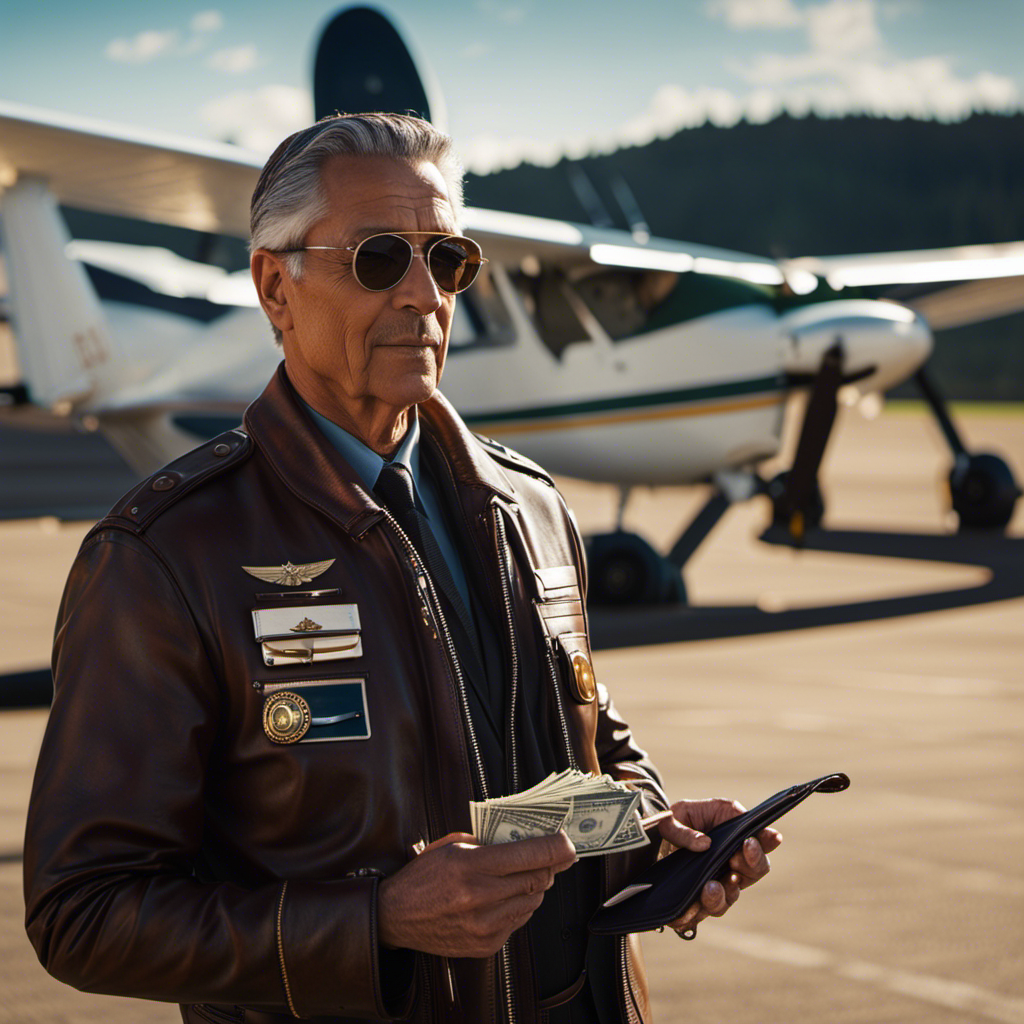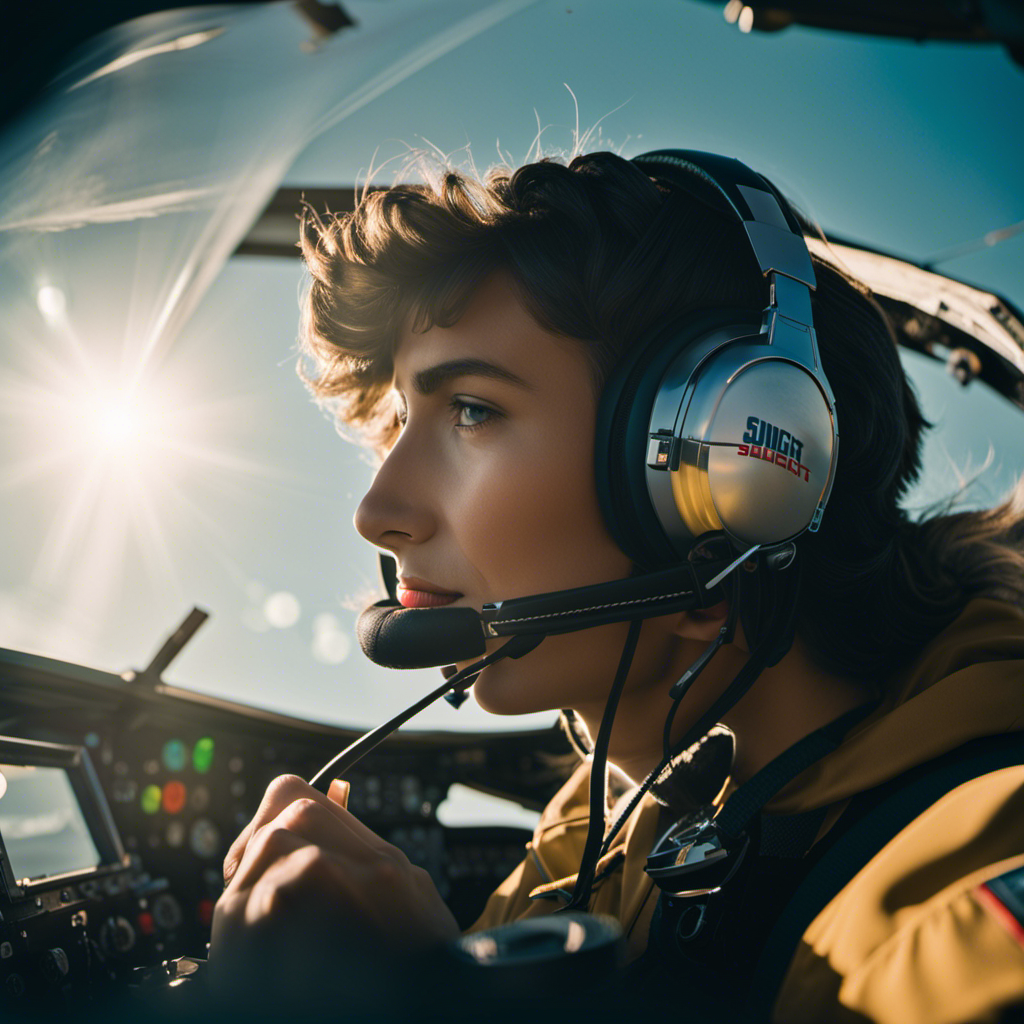You’re reaching for the stars, huh? Well, buckle up and prepare for an exciting journey into the world of aviation.
In this comprehensive guide, I’ll take you through the steps of becoming a pilot, from determining your motivation to pursuing advanced certifications.
With a commitment to detail and a passion for flying, you’ll gain the knowledge and skills needed to soar through the clouds.
Get ready to embark on an extraordinary adventure as we explore the path to fulfilling your soaring ambitions.
Key Takeaways
- Flight hour requirements set by the FAA vary based on pilot licenses and include minimum hours in solo flight, cross-country navigation, and night flying.
- Exceeding the minimum flight hour requirements is important for skill development and gaining more experience as a pilot.
- Pilots can gain more flight hours and experience through additional training options and seeking diverse flight opportunities.
- Specializing in a specific aircraft or field, such as rotorcraft, offers promising career prospects and advancement opportunities with experience and flight hours.
Determine Your Motivation and Commitment Level
Determining your motivation and commitment level is crucial before embarking on the journey to becoming a pilot. A thorough motivation assessment will help you understand your driving force behind this career choice. Are you passionate about aviation? Do you have a genuine interest in aircraft and flying? Assessing your motivation will ensure that you are pursuing this career for the right reasons and that you will be able to stay motivated throughout the challenges that lie ahead.
Additionally, becoming a pilot requires a long term commitment. It involves years of training, continuous learning, and dedication. You must be prepared to invest the necessary time, effort, and resources to achieve your goal.
Transitioning into the next section, researching and choosing the right flight school is essential in starting your pilot journey.
Research and Choose the Right Flight School
Researching and choosing the right flight school can greatly impact your journey to becoming a pilot. It is crucial to find a reputable institution that meets your needs and provides high-quality training. When considering flight schools, there are two key factors to keep in mind: flight school accreditation and financial considerations.
Flight school accreditation:
- Look for schools that are accredited by recognized aviation authorities, such as the Federal Aviation Administration (FAA) in the United States or the European Union Aviation Safety Agency (EASA) in Europe. Accreditation ensures that the school meets strict standards of safety and training.
- Consider the reputation of the flight school within the aviation community. Look for feedback and reviews from current and former students to get an idea of the school’s quality.
Financial considerations:
- Research the cost of training programs, including tuition fees, aircraft rental, and other expenses. It is important to have a clear understanding of the total investment required to complete your training.
- Explore financial aid options, such as scholarships, grants, and loans, to help offset the costs of flight training. Many flight schools offer financial assistance or have partnerships with financing companies.
By carefully considering flight school accreditation and financial considerations, you can make an informed decision that sets you up for success in your pilot training journey.
Now, let’s move on to the next section and explore how to meet the basic requirements for becoming a pilot.
Meet the Basic Requirements
Meeting the basic requirements is essential for starting your journey to becoming a pilot. Before embarking on this exciting career path, it is crucial to consider both the pilot career prospects and the financial considerations involved.
The aviation industry offers promising opportunities for pilots, with a high demand for qualified professionals. However, it is important to understand that the initial costs of training and obtaining the necessary licenses can be significant. Aspiring pilots must be prepared to invest in their education and training, which can involve expenses such as flight school tuition, aircraft rental, study materials, and examination fees.
Despite the financial commitment, the potential for a rewarding career in aviation makes it a worthwhile pursuit. To begin this adventure, the first step is to obtain a student pilot certificate, which will allow you to start your flight training and gain valuable experience in the cockpit.
Obtain a Student Pilot Certificate
Before embarking on your journey to becoming a pilot, it’s important to obtain a student pilot certificate. This certificate is the first step towards your dream of flying.
To obtain a student pilot certificate, you must meet certain requirements set by the Federal Aviation Administration (FAA). These requirements include being at least 16 years old, being able to read, speak, and understand English, and receiving the necessary training from a certified flight instructor.
Speaking of flight instructors, let’s take a closer look at the requirements they must fulfill. Flight instructors must hold a commercial pilot certificate, have at least 250 hours of flight time, and pass a knowledge and practical test.
Now that you understand the importance of obtaining a student pilot certificate and the requirements for flight instructors, you are ready to begin your flight training journey.
In the next section, we will explore how to start your flight training.
Begin Flight Training
Now that you’ve obtained your student pilot certificate, it’s time to start your flight training. This is where you will gain the knowledge and skills necessary to become a proficient pilot.
One important aspect of flight training is finding a qualified flight instructor. They will guide you through the process, teaching you the fundamentals of aviation and helping you develop your flying abilities. It’s crucial to choose an instructor who is experienced, patient, and dedicated to your success.
Additionally, consider exploring aviation scholarships that can provide financial assistance for your flight training. These scholarships are available to aspiring pilots who demonstrate a passion for aviation and a commitment to their training. By investing in flight instructor training and exploring aviation scholarships, you can pave the way for a successful career in aviation.
As you progress through your flight training, the next milestone is to pass the written and practical exams.
Pass the Written and Practical Exams
Once you’ve completed your flight training, passing the written and practical exams is the final step towards obtaining your pilot’s license. It may seem daunting, but with proper preparation and some practical exam tips, you can ace these exams and achieve your dream of becoming a pilot.
Here are some essential tips for written exam preparation:
- Study the FAA Airman Knowledge Test Guide thoroughly.
- Take practice exams to familiarize yourself with the format and types of questions.
- Focus on key topics such as regulations, aerodynamics, weather, and navigation.
- Seek guidance from experienced pilots or instructors for additional resources and study materials.
When it comes to the practical exam, here are a few tips to help you succeed:
- Practice your maneuvers regularly to build confidence and proficiency.
- Review the FAA Practical Test Standards to understand the expectations.
- Communicate effectively with your examiner and demonstrate good decision-making skills.
- Stay calm and composed throughout the exam, remembering to prioritize safety.
Obtain Your Private Pilot License
To obtain your Private Pilot License, there are certain requirements you must meet in terms of flight hours and experience.
The Federal Aviation Administration (FAA) sets the minimum flight hour requirements, which include a specified number of hours in various categories such as solo flight, cross-country navigation, and night flying.
These flight hours and experiences are crucial in developing the necessary skills and knowledge to become a competent and safe pilot.
Required Flight Hours and Experience
You’ll need to accumulate a specific number of flight hours and gain valuable experience in order to become a pilot. Flight hour requirements vary depending on the type of pilot license you are pursuing.
For example, to obtain a Private Pilot License (PPL) in the United States, you must log a minimum of 40 flight hours, including 20 hours of flight instruction and 10 hours of solo flight. However, it’s important to note that these are just the minimum requirements.
Building more flight hours and experience will make you a more skilled and competent pilot. This can be achieved through additional flight training, cross-country flights, and specialized courses.
Once you have completed the necessary flight hours and gained sufficient experience, you will be ready to move on to the next stage of your journey: solo flight and cross-country navigation.
Solo Flight and Cross-Country Navigation
Ready to take on the skies alone and navigate across different locations? Solo flight and cross-country navigation are the next exciting challenges in your journey to becoming a pilot. To prepare for your solo flight, ensure you have met all the necessary requirements, including the required flight hours.
Here’s what you need to know for successful solo flight preparation:
- Familiarize yourself with the aircraft’s operating procedures and emergency protocols.
- Practice takeoffs, landings, and maneuvers under the guidance of your flight instructor.
- Gain confidence by completing solo flights in the local area, gradually increasing your distance from the airport.
- Familiarize yourself with airspace regulations and navigation charts for cross-country flight planning.
Mastering these skills will set the stage for your next adventure: cross-country navigation. Soaring through the skies, charting your course, and exploring new destinations will be an exhilarating experience.
Once you feel comfortable with solo flight and cross-country navigation, you can consider specializing in a specific aircraft or field.
Consider Specializing in a Specific Aircraft or Field
If you’re passionate about helicopters, specializing in rotorcraft could be an exciting avenue to explore in your pilot career. As a rotorcraft specialist, you will gain in-depth knowledge and skills specific to this type of aircraft, allowing you to excel in this specialized field.
There are various specialization options within rotorcraft, such as becoming a helicopter emergency medical services (HEMS) pilot, a search and rescue (SAR) pilot, or a tour pilot. Each specialization offers unique challenges and opportunities to make a difference in people’s lives.
Furthermore, the career prospects for rotorcraft specialists are promising, with a growing demand for skilled pilots in various sectors, including the military, law enforcement, and offshore operations. By specializing in rotorcraft, you can position yourself for a rewarding and fulfilling career in aviation.
As you gain experience and build flight hours, you will continue to grow as a pilot and increase your opportunities for advancement and specialization.
Gain Experience and Build Flight Hours
As you gain experience and build flight hours, you’ll become a more skilled and confident pilot. Building flight time and gaining experience are crucial steps in your journey to becoming a successful aviator. Here are some key ways to accomplish this:
-
Fly regularly: Consistency is key when it comes to building flight hours. Make it a priority to fly as often as possible to gain valuable experience and improve your skills.
-
Seek diverse flight opportunities: Take advantage of different flying conditions, aircraft types, and locations to broaden your knowledge and adaptability as a pilot.
-
Volunteer for additional responsibilities: Offer to assist with flight planning, aircraft maintenance, or other tasks to gain a deeper understanding of the aviation industry and enhance your overall experience.
-
Join aviation organizations: Connect with fellow pilots and professionals in the field by becoming a member of aviation organizations. Attend their events and engage in networking opportunities to learn from experienced pilots and gain insights into the industry.
-
Pursue advanced certifications and career opportunities: As you continue to build flight time and gain experience, consider pursuing advanced certifications and exploring career opportunities that align with your goals and interests.
Pursue Advanced Certifications and Career Opportunities
To enhance your skills and open doors for career growth, pursuing advanced certifications and exploring various career opportunities in the aviation industry is essential. Advanced certifications not only demonstrate your expertise and dedication but also increase your marketability and potential for higher-paying positions. By investing in additional training and certifications, you can specialize in areas such as airline transport, flight instructor, or aircraft maintenance. These certifications provide a competitive edge and make you a valuable asset to airlines, corporate aviation departments, and aviation training organizations. Additionally, pursuing advanced certifications can lead to exciting career opportunities such as becoming a chief pilot, aviation safety inspector, or aviation consultant. The table below highlights some of the advanced certifications and the potential career paths they can lead to:
| Certification | Career Opportunities |
|---|---|
| Airline Transport | Airline Pilot |
| Flight Instructor | Flight Instructor |
| Aircraft Maintenance | Aircraft Technician |
| Aviation Safety | Safety Inspector |
Frequently Asked Questions
What are the costs associated with becoming a pilot?
The cost breakdown of becoming a pilot includes expenses like flight training, license fees, and medical exams. Financing options such as loans and scholarships are available to help cover these costs.
Are there any age restrictions for becoming a pilot?
There are age restrictions for becoming a pilot. The minimum age to start flight training is usually 16 for a student pilot certificate and 17 for a private pilot license. The training duration varies based on the type of pilot license you want to obtain.
What are the physical requirements to become a pilot?
To become a pilot, you must meet physical fitness requirements and have good vision. Physical fitness ensures you can handle the demands of flying, while vision requirements ensure you have the necessary visual acuity for safe operation.
How long does it typically take to obtain a private pilot license?
Obtaining a private pilot license involves several steps. From your first flight lesson to passing the written exam and checkride, it typically takes around 6-12 months to complete the training and earn your license.
What are the job prospects and earning potential for pilots?
Job prospects for pilots are generally favorable, with the aviation industry experiencing growth. Salary potential is also high, with pilots earning competitive wages, especially those with extensive experience and flying for major airlines.
Conclusion
In conclusion, my fellow aspiring aviators, I must say that the path to becoming a pilot is paved with soaring ambitions and endless possibilities.
From determining your motivation to obtaining advanced certifications, this comprehensive guide has equipped you with the knowledge to navigate the skies with confidence.
Remember, flying is not just a hobby, it’s a way of life. So buckle up, strap in, and let your dreams take flight!
Safe travels, my friends.









